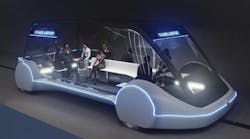Elon Musk’s Boring Future of Fast Transportation!
While most of us have experienced the anger and frustration of being stuck in seemingly endless traffic, few of us would turn this bitter emotion into a new business venture. However, that’s exactly what Elon Musk did when he conceived The Boring Company. With the project aiming to create a network of transportation tunnels under L.A., what materials are required to make Musk’s “boring” vision an exciting reality?
A lot has been said about The Boring Company since Musk first announced it on Twitter at the end of 2016. Since then, we’ve heard many claims that the proposed transportation system—named Loop, based on Musk’s affinity for the hyperloop concept—will transport the public at 150 miles per hour, prospectively taking passengers from New York to Washington D.C. in 29 minutes, for as little as $1. In May 2018, the project received permission to work with the LA County Metropolitan Transportation Agency (MTA) to build a 2.7-mile test tunnel.
The most recent update on the company involved a won bid to create an underground high-speed rail from downtown Chicago to O’Hare International Airport. The new proposal is for a slower Loop system. It will take passengers roughly 18 miles in about 12 minutes. The existing Blue-Line takes about 40 to 45 minutes to travel the same distance.
The vehicles will leave the station every 30 seconds and the express Loop will operate 20 hours per day. The company says that each vehicle would be equipped with a climate-controlled cabin to compete with Chicago’s cold winters and muggy summers, as well as luggage storage space and Wi-Fi. So far, it seems like full steam ahead for The Boring Company.
Passengers will be able to board a transport shuttle every 30 seconds from the airport.
However, the project has drawn criticism from those thinking Musk’s suggestions are simplifying the complexities of the tunneling process that design engineers must consider when developing tunnel boring machines (TBMs). But what are these considerations?
Arguably the most important thing design engineers must keep in mind is the types of substances that will be tunneled through. There are four types of environments that tunneling operations encounter—soft ground, hard rock, soft rock, and underwater—and each has its own unique challenges. In Musk’s boring project, it’s likely he would encounter soft ground and hard rock. Hard rock is as you would expect it to be, and soft ground encompasses things like clay, mud, and silt.
This will directly influence the choice of materials in the equipment. For soft ground applications, TBMs can have a multitude of tools such as drag picks and cutting disks. Since the environment is generally more malleable, these tools theoretically can be made of traditional mining materials such as steel (particularly stainless steel).
The tunnel boring machine pictured above is what will be used to dig out the ground below to make way for Boring’s future transportation system.
Stainless steel is often selected based on its corrosion resistance. Many of these softer ground types include high levels of moisture, so choosing a material with a high corrosion resistance and varying toughness seems like an ideal fit.
To account for chance encounters with harder materials in a soft ground environment, such as a small stone deposit, alternatives such as cemented carbide—also known as tungsten carbide or hard metal — with a nickel-chromium binder can be used to balance high toughness with corrosion resistance.
The considerations are understandably different for hard rock environments where there is less moisture, and a tougher material with high impact and hardness properties is necessary. In these environments, the material of choice is cemented carbide, with a cobalt binder to bolster toughness and heat resistance. This improves performance under the high temperatures that occur when impacting hard rock surfaces.
These material differences are important to note, because it’s likely that the process of tunneling under L.A. would involve interacting with several environments. Design engineers will struggle to find a single material that is effective in both types of soil, so specialized tools with specific materials should be incorporated into the design of a TBM.
For example, cemented carbide could in theory be suitable for such environments, but its effectiveness depends on the binding material. A tungsten carbide that uses cobalt as a binder (WC-Co) may not have sufficient corrosion resistance for soft ground applications. In these situations, the overall effectiveness and toughness of the WC-Co tool would decrease as corrosion affects the material.
Instead, tungsten carbide with nickel-chromium (WC-NiCr) may be a better fit, especially in those environments with lower pH-values, where the corrosion rate using NiCr instead of Co is reduced at least by a factor of 5-10.
Since the hard phase itself does not corrode, any corrosion would occur on the binder phase to leave behind isolated particles of cemented carbide, which could not do their job properly alone. Furthermore, the addition of other refractory metal carbides influences the corrosion behavior significantly.
It’s clear there’s a lot more to material selection in designing tunneling equipment than Musk lets on. That’s why we find many designers working on these projects compare materials using an online database, allowing them to easily make an informed decision to develop an effective product. The material selection process might be complex, but if Musk’s vision for a subterranean transport network becomes reality, the reduction in infuriating congestion will make everybody grateful.
For more information on the future of the hyperloop, visit the Boring Company.
For more information on materials and a database for future projects, visit Matmach’s online materials sourcing database.
Heiko Wilder is a materials scientist at online materials sourcing database Matmatch.



